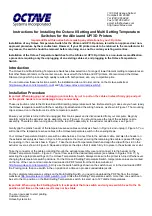
4.2 Description of Menu Items
51
ParallelSettings
Specifies the settings for the parallel interface.
Note
• You need to restart the printer to activate the new settings. After making the settings, turn off the printer
and then turn it on again.
IP Filter
Specifies blocking the reception of data from certain IP addresses.
No. n
(n: 1 to 5)
You can set up to five IP addresses ([No. 1] to [No. 5]). [No. 1] has priority over the
others. To set multiple filters, set IP address in descending order from the address
network with the narrowest range.
• [Address]
Sets the IP address for No. n. You can set values between 0 and 255.
• [Mask]
Sets the mask for No. n. You can set values between 0 and 255.
• [Mode]
Specifies the mode to limits for the registered IP address from [Off] (default), [Accept],
or [Reject].
Note
• The IP filter setting can be set on the CentreWare Internet Services. For example to
set the IP filter, refer to “6.3 Checking / Managing the Printer Status on a Web
Browser” (P. 87).
Initialize NVM
Initializes network data stored in NVM. The NVM is a nonvolatile memory that stores
the printer settings even after power off. Initializing the NVM will revert the value for
each item of the [Network Settings] menu to default.
Adobe Protocol
Specifies the communications protocol for PostScript.
• [Auto] (default)
Used when no special processing is required for data.
• [Standard]
Used when the communication protocol is in ASCII format.
• [BCP]
Used when the communication protocol is in binary format.
• [TBCP]
Used when the communication protocol supports both ASCII and binary data to
switch between them according to the specified control code.
• [Binary]
Used when no special processing is required for data.
Item
Description
ECP
Specifies the ECP communication mode of the parallel interface.
• [Enable] (default)
The ECP communication mode is enabled.
• [Disable]
The ECP communication mode is disabled.
Adobe Protocol
Specifies the communications protocol for PostScript.
• [Auto]
Used when no special processing is required for data.
• [Standard]
Used when the communication protocol is in ASCII format.
• [BCP]
Used when the communication protocol is in binary format.
• [TBCP] (default)
Used when the communication protocol supports both ASCII and binary data to
switch between them according to the specified control code.
• [Binary]
Used when no special processing is required for data.
Item
Description
















































